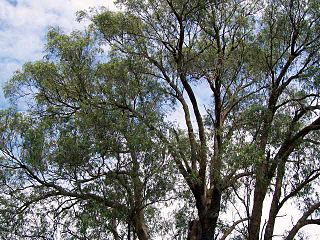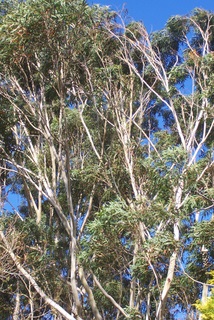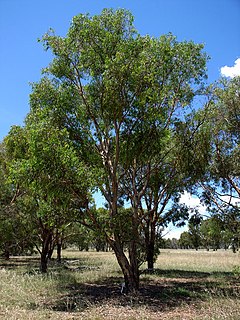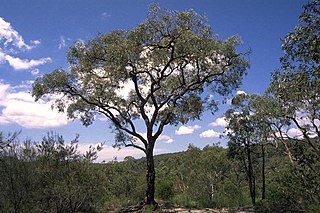
Eucalyptus saligna, commonly known as the Sydney blue gum or blue gum, is a species of medium-sized to tall tree that is endemic to eastern Australia. It has rough, flaky bark near the base of the trunk, smooth bark above, lance-shaped to curved adult leaves, flower buds in groups of seven, nine or eleven, white flowers and cylindrical to conical or cup-shaped fruit.

Eucalyptus grandis, commonly known as the flooded gum or rose gum, is a tall tree with smooth bark, rough at the base fibrous or flaky, grey to grey-brown. At maturity, it reaches 50 metres tall, though the largest specimens can exceed 80 metres tall. It is found on coastal areas and sub-coastal ranges from Newcastle in New South Wales northwards to west of Daintree in Queensland, mainly on flat land and lower slopes, where it is the dominant tree of wet forests and on the margins of rainforests.

Eucalyptus botryoides, commonly known as the bangalay, bastard jarrah, woollybutt or southern mahogany, is a small to tall tree native to southeastern Australia. Reaching up to 40 metres high, it has rough bark on its trunk and branches. It is found on sandstone- or shale-based soils in open woodland, or on more sandy soils behind sand dunes. The white flowers appear in summer and autumn. It reproduces by resprouting from its woody lignotuber or epicormic buds after bushfire. E. botryoides hybridises with the Sydney blue gum in the Sydney region. The hard, durable wood has been used for panelling and flooring.

Eucalyptus rubida, commonly known as candlebark, ribbon gum or white gum, is a species of small to medium-sized tree that is endemic to south-eastern Australia. It has smooth bark, sometimes with rough bark at the base, lance-shaped or curved adult leaves, flower buds in groups of three, white flowers and cup-shaped, hemispherical or bell-shaped fruit.

Eucalyptus macarthurii, commonly known as the Camden woollybutt or Paddy's river box, is a species of medium-sized tree that is endemic to a small area of New South Wales. It has rough, fibrous bark on the trunk and larger branches, smooth above, narrow lance-shaped to curved adult leaves, flower buds in groups of seven, white flowers and small conical to bell-shaped fruit.

Eucalyptus nitens, commonly known as shining gum or silvertop, is a species of tall tree native to Victoria and eastern New South Wales. It has smooth greyish bark, sometimes with thin, rough bark near the base, lance-shaped adult leaves, flower buds in groups of seven or nine, white flowers and cup-shaped, barrel-shaped or cylindrical fruit. It grows in wet forests and rainforest margins on fertile soils in cool, high-rainfall areas.

Eucalyptus pilularis, commonly known as blackbutt, is a species of medium-sized to tall tree that is endemic to eastern Australia. It has rough, finely fibrous greyish bark on the lower half of the trunk, smooth white, grey or cream-coloured bark above, lance-shaped to curved adult leaves, flower buds in groups of between seven and fifteen, white flowers and hemispherical or shortened spherical fruit.

Eucalyptus notabilis, commonly known as Blue Mountains mahogany or mountain mahogany, is a species of small to medium-sized tree endemic to eastern Australia. It has rough, fibrous bark on the trunk and branches, lance-shaped to curved adult leaves, flower buds in groups of between seven and eleven, white flowers and hemispherical or conical fruit.

Eucalyptus oreades, commonly known as the Blue Mountains ash, white ash or smooth-barked mountain ash, is a species of medium-sized to tall tree that is native to eastern Australia. It has smooth, powdery whitish bark with rough bark near the base, lance-shaped to curved adult leaves, flower buds in groups of seven, white flowers and cup-shaped to cylindrical fruit.

Eucalyptus fraxinoides, commonly known as the white ash or white mountain ash, is a medium-sized to tall tree of mountain country and is endemic to south eastern Australia. It has rough, compacted greyish bark on the lower trunk, smooth white bark with scribbles above, lance-shaped adult leaves, flower buds in groups of between seven and eleven, white flowers and barrel-shaped or urn-shaped fruit.

Eucalyptus fastigata, commonly known as brown barrel or cut-tail, is a species of medium-sized to tall tree that is endemic to southeastern Australia. It has fibrous or stringy bark on the trunk and larger branches, smooth bark above, lance-shaped to curved adult leaves, flower buds in groups of eleven or more, white flowers and conical or pair-shaped fruit.

Eucalyptus propinqua, commonly known as the grey gum or small-fruited grey gum, is a species of medium-sized to tall tree that is endemic to eastern Australia. It has smooth, mottled bark, lance-shaped to curved adult leaves that are paler on the lower surface, flower buds in groups of between seven and fifteen, white flowers and conical or hemispherical fruit.

Eucalyptus parramattensis, commonly known as the Parramatta red gum or drooping red gum, is a species of small to medium-sized tree that is endemic to eastern New South Wales. It has smooth, mottled bark, lance-shaped to curved adult leaves, flower buds in groups of seven, white flowers and hemispherical fruit.

Eucalyptus quadrangulata, commonly known as the white-topped box or coast white box, is a species of small to medium-sized tree that is endemic to eastern Australia. It has rough, fibrous or flaky bark on the trunk and branches, lance-shaped to curved adult leaves, flower buds in groups of seven, white flowers and conical fruit.

Eucalyptus conica, commonly known as fuzzy box, is a species of tree endemic to eastern Australia. It has rough, flaky bark on the trunk and larger branches, smooth above, lance-shaped adult leaves, oval to diamond-shaped flower buds mostly arranged on a branching inflorescence on the ends of the branchlets, white flowers and conical fruit.

Eucalyptus squamosa, commonly known as scaly bark, is a species of small to medium-sized tree that is endemic to the Sydney region in New South Wales. It has rough, tessellated, fibrous or flaky bark, lance-shaped or curved adult leaves, flower buds in groups of seven, nine or eleven, white flowers and cup-shaped or hemispherical fruit.

Eucalyptus badjensis, commonly known as the Big Badja gum, is a tree that is endemic to south-eastern New South Wales. It has hard, rough bark on the lower part of the trunk, smooth grey bark above, often hanging in strips on the upper branches, linear to narrow lance-shaped, often curved adult leaves, green to yellow buds in groups of three in leaf axils, white flowers and conical or bell-shaped fruit.

Eucalyptus blaxlandii, commonly known as Blaxland's stringybark, is a tree that is endemic to south eastern New South Wales. It is a stringybark with lance-shaped adult leaves, flower buds arranged in group of nine or eleven, white flowers and hemispherical fruit.

Eucalyptus parvula, commonly known as small-leaved gum, is a species of small tree that is endemic to south-eastern New South Wales. It has mostly smooth bark, elliptical to lance-shaped adult leaves but with many juvenile of intermediate leaves in the crown, flower buds in groups of seven, white flowers and cup-shaped fruit.

Eucalyptus benthamii, commonly known as Camden white gum, Bentham's gum, Nepean River gum, kayer-ro or durrum-by-ang, is a species of tree that is endemic to New South Wales. It has mostly smooth bluish grey or white bark, lance-shaped to curved adult leaves, flower buds arranged in groups of seven, white flowers and cup-shaped, bell-shaped or conical fruit.






















